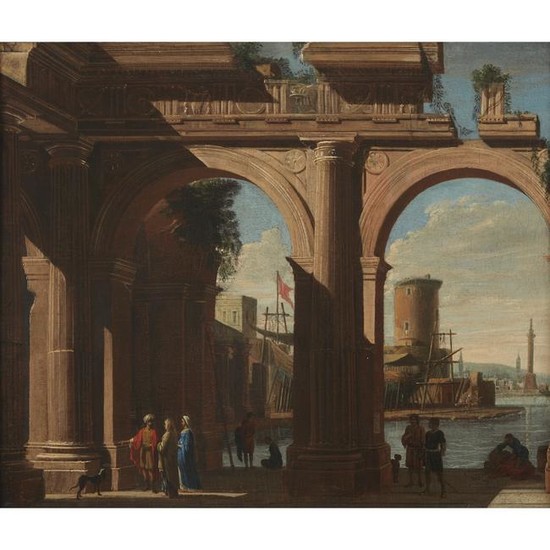Viviano Codazzi (Italian, c.1604–1670), , Doric Arcade
Viviano Codazzi (Italian, c.1604–1670)
Doric Arcade, with the Torre di S. Vincenzo
Oil on canvas
23 1/2 x 29 3/8 in. (59.7 x 74.6cm)
Executed in the early 1660s.
PROVENANCE:
Collection of R. Henshaw, Bath, United Kingdom.
Alexander Galleries, London, United Kingdom (by 1978).
Collection G. Lotto, Milan, Italy.
William Thuiller, London, United Kingdom, 1985.
Osuna Galleries, Washington, D.C.
Acquired directly from the above in 1986.
Private Collection, Washington, D.C.
LITERATURE:
Giuliano Briganti et al., “Vivano Codazzi” in I Pittori Bergamaschi, no. 4, vol. 1, pp. 643-741, 1983, no. 29, p. 691, illustrated p. 712 (as by Codazzi and van der
Cabel).
Ramon Osuna, The Pleasure of Ruins: Viviano Codazzi
and His Legacy, Osuna Gallery, Washington, D.C.; and Shepherd Gallery, Associates, New York, 1985, no. 9 (illustrated as by Codazzi and Gargiulo).
David Riley Marshall, Viviano and Niccolò Codazzi and the Baroque Architectural Fantasy, Jandi Sapi, Milan, 1993, no. VC 170, pp. 296-297 (illustrated p. 297 as by Viviano Codazzi and Adriaen van der Cabel (?)).
NOTE:
Viviano Codazzi was arguably the most important 17th century Italian painter of architectural views, specializing in capricci-architectural fantasies. The present painting depicts the arsenal in Naples and the Torre di San Vincenzo, with the Molo Grande and its lighthouse in the distance. There are two arches of a Doric arcade and a colonnade advancing from a pier at left, along with several groups of figures-including the group at left with a man wearing a turban and women wearing long gowns and head coverings (David Ryley Marshall, Viviano and Niccolò Codazzi and the Baroque Architectural Fantasy, Milan and Rome, 1993, pp. 1, 296).
David Ryley Marshall notes that Codazzi's works may be grouped into "five main categories of imagery. They are the capriccio, ideal architecture, the ruin piece, the topographical picture, and the didactic picture" (Marshall, op. cit., p. 23). However, of these, "the capriccio is most central to Codazzi's preoccupations, and all of his works are to a greater or lesser degree capricci." (Marshall, op. cit. p. 23). Marshall continues: "Codazzi's capricci are those works which are imaginary compositions assembled from several motifs whether recognisable or not, which are derived from separate sources and do not make up an architecturally unified structure." (Marshall, op. cit., p. 23).
Codazzi was associated with the artist Adriaen van der Cabel and may have collaborated with him between 1660-1665. Further, the Torre di San Vincenzo was a favored motif of van der Cabel's, and that artist did depict women in long gowns with covered heads. The present work may thus be a collaborative effort between the two artists, with van der Cabel possibly having painted the figures (Marshall, op. cit., pp. 18-19, 296). Viviano Codazzi's son, Niccolò (1642-1693) was also an esteemed architectural capriccio painter in his own right, and may have been in his father's workshop in the 1660s, the two working closely together during this period (Marshall, op. cit., p. 20). Dimensions:
Sale price
Estimate
Time, Location
Auction House
Viviano Codazzi (Italian, c.1604–1670)
Doric Arcade, with the Torre di S. Vincenzo
Oil on canvas
23 1/2 x 29 3/8 in. (59.7 x 74.6cm)
Executed in the early 1660s.
PROVENANCE:
Collection of R. Henshaw, Bath, United Kingdom.
Alexander Galleries, London, United Kingdom (by 1978).
Collection G. Lotto, Milan, Italy.
William Thuiller, London, United Kingdom, 1985.
Osuna Galleries, Washington, D.C.
Acquired directly from the above in 1986.
Private Collection, Washington, D.C.
LITERATURE:
Giuliano Briganti et al., “Vivano Codazzi” in I Pittori Bergamaschi, no. 4, vol. 1, pp. 643-741, 1983, no. 29, p. 691, illustrated p. 712 (as by Codazzi and van der
Cabel).
Ramon Osuna, The Pleasure of Ruins: Viviano Codazzi
and His Legacy, Osuna Gallery, Washington, D.C.; and Shepherd Gallery, Associates, New York, 1985, no. 9 (illustrated as by Codazzi and Gargiulo).
David Riley Marshall, Viviano and Niccolò Codazzi and the Baroque Architectural Fantasy, Jandi Sapi, Milan, 1993, no. VC 170, pp. 296-297 (illustrated p. 297 as by Viviano Codazzi and Adriaen van der Cabel (?)).
NOTE:
Viviano Codazzi was arguably the most important 17th century Italian painter of architectural views, specializing in capricci-architectural fantasies. The present painting depicts the arsenal in Naples and the Torre di San Vincenzo, with the Molo Grande and its lighthouse in the distance. There are two arches of a Doric arcade and a colonnade advancing from a pier at left, along with several groups of figures-including the group at left with a man wearing a turban and women wearing long gowns and head coverings (David Ryley Marshall, Viviano and Niccolò Codazzi and the Baroque Architectural Fantasy, Milan and Rome, 1993, pp. 1, 296).
David Ryley Marshall notes that Codazzi's works may be grouped into "five main categories of imagery. They are the capriccio, ideal architecture, the ruin piece, the topographical picture, and the didactic picture" (Marshall, op. cit., p. 23). However, of these, "the capriccio is most central to Codazzi's preoccupations, and all of his works are to a greater or lesser degree capricci." (Marshall, op. cit. p. 23). Marshall continues: "Codazzi's capricci are those works which are imaginary compositions assembled from several motifs whether recognisable or not, which are derived from separate sources and do not make up an architecturally unified structure." (Marshall, op. cit., p. 23).
Codazzi was associated with the artist Adriaen van der Cabel and may have collaborated with him between 1660-1665. Further, the Torre di San Vincenzo was a favored motif of van der Cabel's, and that artist did depict women in long gowns with covered heads. The present work may thus be a collaborative effort between the two artists, with van der Cabel possibly having painted the figures (Marshall, op. cit., pp. 18-19, 296). Viviano Codazzi's son, Niccolò (1642-1693) was also an esteemed architectural capriccio painter in his own right, and may have been in his father's workshop in the 1660s, the two working closely together during this period (Marshall, op. cit., p. 20). Dimensions:



